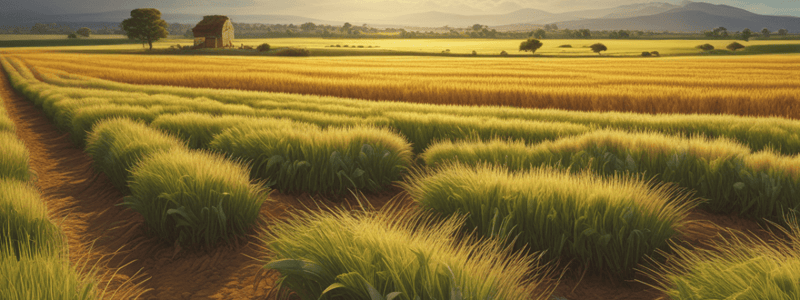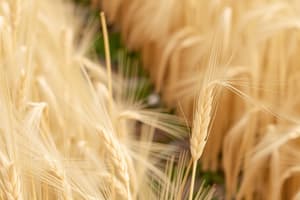Podcast
Questions and Answers
What is the optimal pH range for barley growth?
What is the optimal pH range for barley growth?
6.0-7.5
What is the purpose of crop rotation in barley production?
What is the purpose of crop rotation in barley production?
To prevent disease buildup
What is the importance of proper soil texture and structure in barley growth?
What is the importance of proper soil texture and structure in barley growth?
It affects water retention and drainage
What is the goal of conservation tillage in barley production?
What is the goal of conservation tillage in barley production?
What is the importance of proper irrigation management in barley production?
What is the importance of proper irrigation management in barley production?
What is the purpose of monitoring environmental conditions in barley production?
What is the purpose of monitoring environmental conditions in barley production?
What is the importance of proper drying and storage of barley grains?
What is the importance of proper drying and storage of barley grains?
What is the purpose of personal protective equipment (PPE) in barley production?
What is the purpose of personal protective equipment (PPE) in barley production?
Study Notes
Barley Growth and Management
Growth Cycle of Barley
- Barley growth cycle consists of 9 stages: germination, seedling, tillering, stem elongation, booting, heading, flowering, grain filling, and maturity
- Each stage is critical for optimal crop development
Soil Quality and Preparation
- Optimal soil pH for barley growth is 6.0-7.5
- Fine, firm seedbed is essential for proper seed germination and establishment
- High-quality, disease-resistant varieties should be selected for sowing
- Proper depth and spacing of seeds are crucial for optimal growth
Soil Factors and Productivity
- Nutrient availability, soil texture, and structure affect barley productivity
- Water retention and drainage are critical for healthy plant growth
- Soil pH and organic matter levels impact nutrient availability and overall soil health
Crop Protection Against Diseases
- Using resistant varieties is an effective way to manage diseases
- Crop rotation helps reduce disease incidence and promotes soil health
- Fungicide application can be used in conjunction with other methods
- Proper field sanitation is essential for preventing disease spread
Sustainable Development Implications
- Reduced chemical use promotes environmental sustainability
- Conservation tillage helps reduce soil erosion and promotes soil health
- Integrated pest management (IPM) strategies minimize environmental impact
- Biodiversity enhancement through crop rotation and other practices promotes ecosystem health
Crop Management Factors
- Balanced fertilization is essential for optimal plant growth
- Irrigation management is critical for water conservation and plant health
- Weed control is necessary to prevent competition for nutrients and water
- Monitoring and adapting to environmental conditions is crucial for optimal crop management
Harvesting and Storage Techniques
- Timely harvesting at optimal moisture content is essential for quality grain
- Modern machinery use improves harvesting efficiency
- Proper drying to 12-14% moisture prevents spoilage
- Safe storage conditions are necessary to prevent spoilage and maintain quality
Safe Work Practices
- Proper training and equipment usage are essential for worker safety
- Safe handling procedures prevent accidents and injuries
- Regular maintenance of machinery ensures safety and efficiency
- Adequate storage facilities are necessary for safe storage and handling
Farm Safety Controls and Precautions
- Regular risk assessments identify potential hazards
- Use of personal protective equipment (PPE) prevents injuries
- Safe chemical handling and storage prevent accidents and environmental damage
- Emergency preparedness plans ensure prompt response to accidents
Farm Health and Safety Hazards
- Machinery-related injuries can be prevented with proper training and safety measures
- Exposure to chemicals can be minimized with proper handling and storage procedures
- Ergonomic issues from repetitive tasks can be mitigated with regular breaks and proper equipment design
- Environmental hazards, such as weather conditions, can be mitigated with emergency preparedness plans
Studying That Suits You
Use AI to generate personalized quizzes and flashcards to suit your learning preferences.
Related Documents
Description
Test your knowledge on the growth cycle and soil requirements for optimal barley crop development. Learn about the 9 stages of barley growth and ideal soil conditions for maximum yield.




